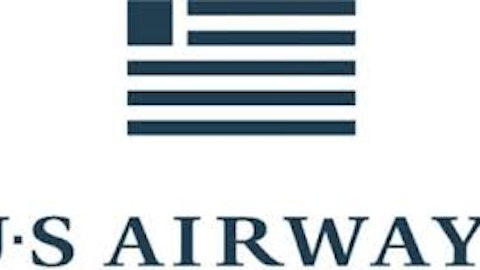
Pressured by creditors, AMR’s CEO, Tom Horton, is serious about the merger. At first, Horton believed American Airlines would be able to successfully navigate through the bankruptcy on its own but has come under pressure from AMR’s bondholders and has agreed to consider all options. Unfortunately, these options are not many as there is no other suitor for AMR Corporation.
According to reports, the combined entity would be headed by U.S. Airways’ Chief Executive Doug Parker while AMR’s Tom Horton would become non-executive chairman of the board.
Horton is expected to remain on the scene until the transition is completed. The transaction, likely to involve stock but no cash, values the combined entity at $11 billion – enough to put it ahead of United Continental Holdings Inc(NYSE:UAL).
The combined carrier would still be behind Delta Air Lines, Inc. (NYSE:DAL) which has over $12.5 billion in terms of market capitalization. Under the terms of the deal, AMR creditors would get to own 72 percent of the new company while the remaining will rest with AMR shareholders.
Enough has already been written about the benefits of the merger and how the combined entity will have little overlap and would enjoy synergies anywhere between $1 billion and $2 billion annually.
What retail investors need to know is if there is a way to benefit from the deal and if yes, how? Unfortunately, the hailed transaction falls flat in this department. Investors should be cautious regarding AMR’s inflated share price. The shares are up nearly threefold over the past quarter, and these shares are not likely to find a place in the larger scheme of things.
From the standpoint of buying US Airways Group, Inc. (NYSE:LCC) stock, the story of leveraging synergies will unfold over a longer term and will be subject to several operational issues, including the whole integration exercise. The stock is already up substantially and is trading close to its 52 week high. Considering the vastly improved results the company has posted in the recent quarters, this is justified but simultaneously opens a downside too.
As many experts reckon, mergers and acquisitions face many unknown challenges during the integration of operations. The downside for U.S. Airways shares, which are already flying high, could easily be bigger than the potential gains. The company has impressed with its standalone performance. For the fourth quarter ended December 31 (one of the slowest in a year) – US Airways reported a 4% increase in operating revenues, while net income more than doubled to $37 million. For the full year, US Airways had a 6% increase in revenues to $3.9 billion, while net income soared from $180 million to $702 million.
What it eventually boils down to is a zero sum game in which the benefits of the transaction are already factored into U.S. Airways stock price. The combined entity would certainly be a reason to worry for its main competitors United Continental Holdings and Delta. The latest quarterly results of these airlines indicate that these market leaders need some immediate action to prop up their margins. United Continental swung from operating loss of $465 million in the fourth quarter of 2011 to a profit of $45 million in the fourth quarter of 2012. However, revenue for United Continental dropped 2.5% to $8.7 billion. Delta Air Lines reported top line growth in the quarter but its operating profit halved to $352 million as aircraft fuel and related taxes zoomed 18%. Both carries are preparing to support margins by cutting flying capacity – enabling the companies to charge more for remaining seats. However, whether the plan succeeds is still to be determined.
It is not clear as yet what strategy the new American Airlines would adopt to match its competitors’ margins but initially the company will have an advantage in undercutting its rivals as lower margins would be more than acceptable amid restructuring and integration charges.
The article US Airways, AMR Merger: Strike Ball? originally appeared on Fool.com and is written by Jacob Wolinsky.
Copyright © 1995 – 2013 The Motley Fool, LLC. All rights reserved. The Motley Fool has a disclosure policy.



